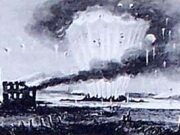Over the course of the Civil War (1861-65), three different fighting ships of the Confederate navy were given the name Savannah. All three ships saw only limited action along the Georgia coast during the war.
Privateer Savannah
The first ship to carry the name Savannah, this fifty-three-ton schooner was converted to an Atlantic Coast privateer after hostilities began in 1861. The ship was lightly armed with a single eighteen-pounder cannon, of War of 1812 (1812-15) vintage, that had been converted into a rifled gun. The privateer Savannah took one merchant ship as a prize of war before being captured by the brigadier USS Perry after two weeks of service.
CSS Savannah (Gunboat)
The second ship to carry the name, the gunboat Savannah (later called Old Savannah), was originally a side-wheel steamer named Everglade. It was built in 1856 at New York and purchased early in 1861 by the state of Georgia to be converted into a gunboat for coastal defense. With a moderate 406-ton displacement, the Savannah was armed with a single thirty-two-pounder cannon. Under the command of Lieutenant J. N. Maffitt, the Savannah was attached to the squadron of Flag Officer Josiah Tattnall, charged with the defense of Georgia and South Carolina. Tattnall’s command of gunboats was so small that he dubbed it the “Mosquito Fleet.” The tiny flotilla, which consisted of three converted tugs (the Resolute, Sampson, and Lady Davis) and a converted harbor craft (the Savannah) was no match for Union ships on the open sea, but the shallow draft of the small ships gave them a movement advantage in inland waters.
On November 5-6, 1861, the CSS Savannah, in company with the Resolute, Sampson, and Lady Davis, fought vessels from a much larger Union fleet of fifty-one ships under Flag Officer Samuel F. Du Pont. The fleet was preparing to attack Confederate positions at Port Royal Sound, South Carolina, between Savannah and Charleston. On November 7 the Savannah again briefly engaged with Union ships as they bombarded Fort Walker and Fort Beauregard. When this token defense was driven off by the Union fleet, Tattnall failed in his attempt to join the garrison at Fort Walker. The Savannah returned to the city of Savannah to repair damages, allowing the unopposed Union fleet to successfully take Port Royal and the town of Beaufort, South Carolina.
On November 26, 1861, Tattnall led the Savannah, Resolute, and Sampson, from Fort Pulaski to the mouth of the Savannah River, where the flotilla once again attacked the much larger force of Union vessels stationed there. The Savannah’s attack caused no damage but did force the Union fleet to operate with caution in the following months. On January 28, 1862, Tattnall ran his three ships through a”gauntlet” of thirteen Union gunboats to provision Fort Pulaski. Fortunately for the Confederates, Union batteries held their fire, hoping to bottle up the Confederate fleet and capture its ships. Tattnall managed to make the return trip safely through a hail of fire. Union forces subsequently constructed additional batteries on shore and further fortified their positions. Thereafter, the Savannah was no match for the combination of Union fleet and shore batteries.
Following the surrender of Fort Pulaski after a ferocious two-day shelling by Union guns on April 10-11, 1862, the gunboat Savannah served as a receiving ship at the city of Savannah. Its name was changed to the Oconee when the new Confederate ironclad CSS Savannah assumed the name in early 1863. In June 1863 the Oconee sailed toward England with a load of cotton to be exchanged for ammunition and other supplies but sank on August 18, 1863, before reaching its destination.
CSS Savannah (Ironclad)
The final ship to carry the name, the CSS Savannah was one of six ironclad rams built by the Confederacy. Although the ship saw limited action, its presence was a significant deterrent to Union plans to invade the coastal region of the Savannah River. The ironclad was constructed by F. Willink at the Savannah Shipyards. Its iron plates were manufactured in Atlanta, then transported to Savannah, where they were cut, drilled, and mounted. With a length of 172.5 feet, a 34-foot beam, and a 12.5-foot draft, the Savannah featured a conventional hull and casement with single screw, with 4 inches of iron armor over 22 inches of wood.
The Savannah’s armament included two 7-inch rifled cannons and two 6.4-inch Brooks guns. The engines, built in Columbus, were significantly underpowered. Although considered among the best ships built by the Confederacy, the Savannah boasted an estimated top speed of only six knots. It took almost thirty minutes to make a 180-degree turn. The crew consisted of 180 officers and men.
Launched on February 4, 1863, the ironclad Savannah was transferred in June to naval forces under Flag Officer William Hunter on the Savannah River. The ship remained on the river and did not engage in battle until Union general William T. Sherman approached the city of Savannah in December 1864, at the end of his march to the sea. Unable to prevent the city’s capture, the Savannah remained on the river for two days to protect William J. Hardee’s withdrawal across an improvised pontoon bridge, built with the help of the Savannah’s crew.
On December 20, 1864, the ironclad engaged in a spirited daylong artillery duel with Union guns, becoming the last ship of the Confederacy to fight in Georgia waters. When the Savannah attempted to escape, the ship was trapped by the South’s own torpedo mines, leaving it a “trapped lion,” in the words of General Sherman. On December 21 Tattnall ordered the Savannah to be burned to prevent capture. The ironclad was run aground on the South Carolina shore and set afire. The ensuing explosion was reported to have lit up the night sky for miles.




